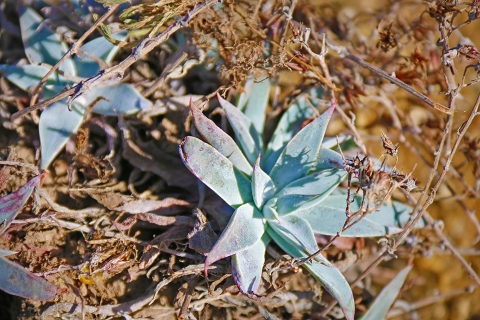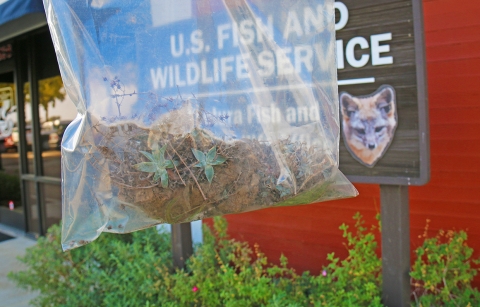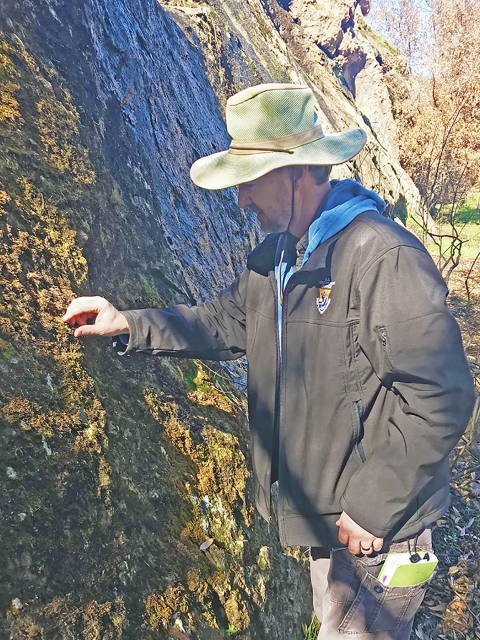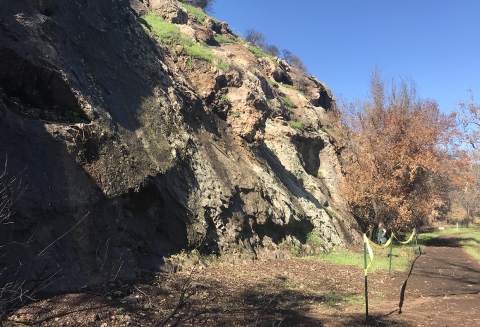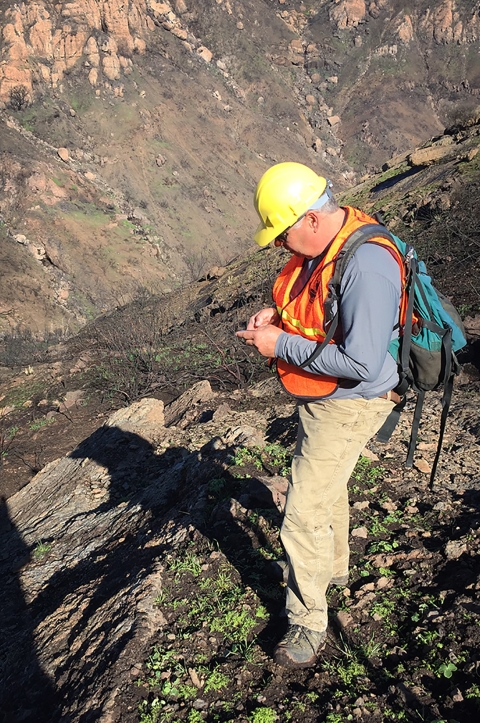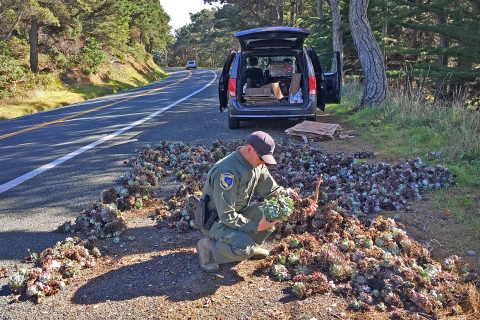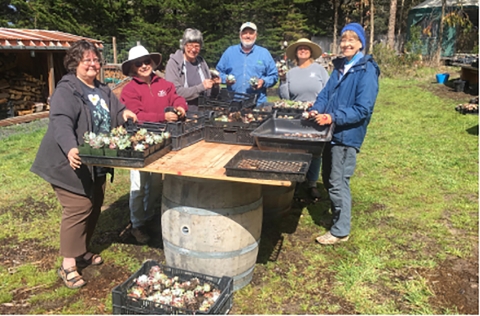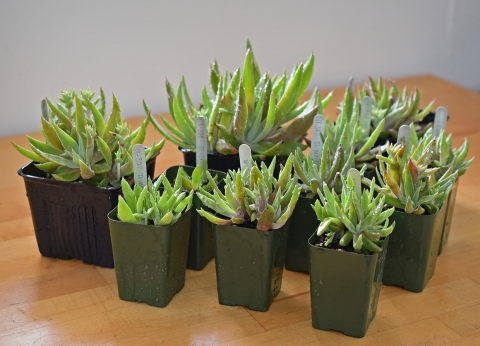By Ashley McConnell
A few hundred meters from the start of a trailhead on the western edge of the Santa Monica Mountains, Ken Niessen and Mark Elvin stop in their tracks. They are surveying areas impacted by wildfires in Southern California, and checking on rare plant species that live there.
While they expect to see acres of charred earth and burned tree limbs just days after a recent wildfire that swept through Ventura and Los Angeles counties, it’s what they see a few miles away that captures their undivided attention. One, and then another, and then another. Hand-sized clumps of soil and rock seemingly dropped in a straight line feet apart along a dusty trail. To the casual hiker, inconsequential obstacles to be passed over, but to professional botanists Niessen and Elvin with the U.S. Fish and Wildlife Service’s Ventura office, these clumps, and their contents, were a much more interesting and concerning find.
“Ok, there’s something weird going on here,” Elvin says, as he carefully picks up a clump. In his hand is a plant the color of light sage with about a dozen rosettes, or clusters of red-tipped leaves.
“It’s Verity’s dudleya,” Elvin says.
Verity’s dudleyas are a type of succulent that live on cliff faces in the Santa Monica Mountains of Ventura County and nowhere else on earth.
Dudleyas are more popularly known as ‘liveforevers,’ aptly named for their hardiness by early English explorers in the Americas.
The specimens they collected, to the explorers’ surprise, survived the long ocean voyage back to England pressed between the pages of their field books.
Today, this particular species of dudleya is hanging on, quite literally, by mere threads. Nearly wiped out by intense wildfires, these charismatic mini-flora, and others like them, now face a new threat from poachers engaged in a lucrative and illegal succulent trade.
Niessen and Elvin carefully gathered the plant material in ziplock baggies as evidence, and alerted state and federal law enforcement officials to the suspicious find.
While officials cannot confirm these particular dudleyas were poached, Patrick Freeling, a game warden with the California Department of Fish and Wildlife, says the signs are there.
“From all of the poaching incidents I’ve seen, they’re shoving backpacks full of plants, and then some of the plants fall out as they bail. You’ll find clumps of plants in the area the next day where they were freshly harvested.”
There are documented cases of succulent poaching in Southern California dating back at least two decades, but officials say the trend is increasing in frequency and severity. Collecting rare plants, particularly those categorized as either threatened or endangered like the Verity’s dudleya, is a violation of state and federal law.
John Tiszler, plant ecologist with the Santa Monica Mountains National Recreation Area, says that the Vertity’s dudleya population was already reduced by up to 90 percent due to wildfires in 2013, and because of extreme drought conditions there has been little to no recovery of the population.
“It's not an unreasonable thought that the species is in danger of being lost,” Tiszler says. “Whether the plants were poached, vandalized, or simply collected out of curiosity, the taking of even a small number of these plants could have a significant impact and ultimately threatens the long-term survival of the species.”
Poaching of dudleyas, primarily more common types, has become a serious concern for local officials and conservation organizations, threatening not just the plants themselves but the ecosystems in which the plants live.
Dudleyas are a food source for native wildlife from land snails and rabbits to ground squirrels and deer. “They hold lots of water when water is not readily available, so they’re a popular food source for many animals, particularly in drought-stricken California,” Elvin says.
There are around 80 kinds of dudleya plants in the world, and more than 70 percent of those dudleyas exist only in California.
“We’re in the epicenter of dudleya country,” says Niessen. Nine of those dudleya types, like the Verity’s dudleya, are considered threatened or endangered under federal or state law. Four of the nine live in the Santa Monica Mountains and nowhere else.
“As far as plants go, they are pretty charismatic,” says Elvin. “Someone might say, ‘Wow, this is going to be a great little plant for my window sill’ and take the plant home with them. In other cases, the ‘taking’ may be more organized.”
Freeling says that some of the more common dudleya species are selling on average for $50 to $100 per plant. And the demand, mostly from international markets, is hitting California hard.
A string of poaching cases involving mass shipments of dudleya plants to South Korea and China were prosecuted in California in 2018. Sentencing for offenders ranged from probation and community service to hefty fines and even jail time. In some cases, perpetrators were barred from future U.S. entry. Most of the cases have been in areas of Northern California in Mendocino and Humboldt counties.
However, the trend appears to be making its way south. In Monterey County in 2019, two people were sentenced to jail time, $14,000 in fines, and $10,000 in additional restitution for felony grand theft, felony vandalism, and take of plants from a California state park. State officials say a Monterey resident witnessed the poachers in action last summer and provided key evidence - photos of the assailants and their license plate - that helped crack the case.
“California is an incredibly special place, a global biodiversity hotspot with more plant diversity than any other state in the U.S.,” says Dan Gluesenkamp, executive director for the California Native Plant Society. “This is our legacy to protect, which is why it’s so great to see everyday Californians stepping forward to report problems and help.”
When word of the poaching first broke, the society jumped into action to help spread the word and repair the fragile dudleya ecosystems. Last spring, trained volunteers from the society - North Coast chapter worked with state and federal partners to replant stolen dudleya along the coast. Now, the society has engineered a novel solution to curtail future poachers: The organization is overseeing mass nursery production of thousands of dudleyas that will be given away for free in order to flood the market and eliminate financial gains for poachers. “You want dudleyas, we’ve got ‘em for free! Just not from our wildlands!” Gluesenkamp says.
While Elvin and Niessen’s find along the Santa Monica Mountains trailhead has yet to be confirmed as a poaching incident, they are concerned that this new threat could decimate already dwindling dudleya populations in the area.
The U.S. Fish and Wildlife Service, National Park Service, California Department of Fish and Wildlife, and other partners are working together to exchange information and get a handle on the growing problem.
“Much like our state counterparts, we simply cannot be everywhere, all of the time,” says Dan Crum, special agent in charge for the U.S. Fish and Wildlife Service's Pacific Southwest Region Office of Law Enforcement. “The public can play an integral role in curbing the illegal wildlife trade, to include the unlawful collection and commercialization of rare and endemic plant species, such as the dudleya, simply by reporting potential poaching incidents to the proper authorities.”
As for the mysterious clumps found on the trailhead in the Santa Monica Mountains, they are in the capable hands of botanists and horticulturists at the Santa Barbara Botanic Garden, a conservation-oriented non-profit organization that houses the Nationally Accredited Plant Collection of Dudleya.
Grouped for safe-keeping with other rare dudleyas in a non-public portion of the Garden, the salvaged clumps of Verity’s dudleya have recovered and will be used to help grow more of the rare plants to help boost the wild population.
“Verity’s dudleya is so rare that every individual counts,” says Matt Guilliams, curator of the Clifton Smith Herbarium at the Santa Barbara Botanic Garden. “A silver lining to this potential poaching incident is that we now have plants in our conservation collection, where they can be used to produce seed and additional plants for restoration."
The public can report suspicious activity by contacting the U.S. Fish and Wildlife Service Office of Law Enforcement at 1-844-FWS-TIPS, or the California Department of Fish and Wildlife’s CalTIP at 1-888-334-CalTIP. Tips can be submitted anonymously.

